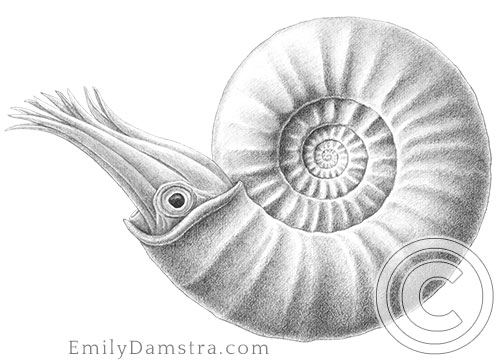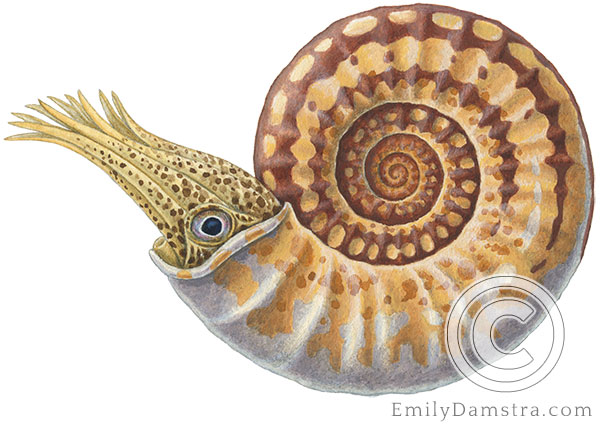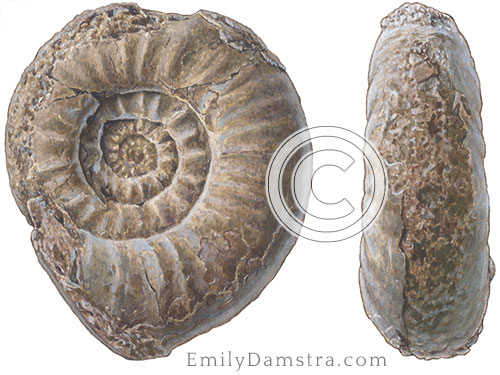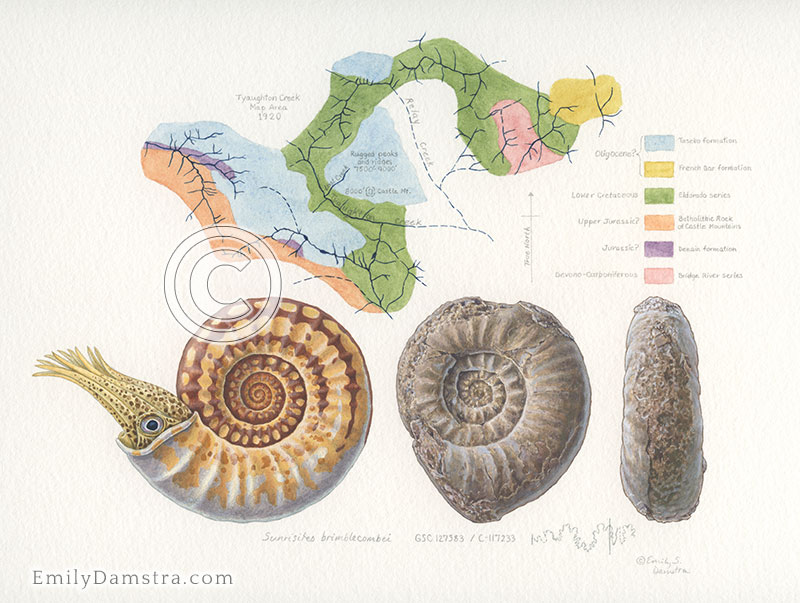This past April I completed a commission for amateur paleontologist W.C. (Cory) Brimblecombe, who asked me to create a painting of an Early Jurassic ammonoid fossil. (Ammonoids are extinct relatives of squid.) Cory envisioned a collage of four components: the fossil specimen in two views, a reconstruction of the living animal in color, and a map of the area where he collected the fossil.
The first challenge was that I would not have access to the fossil specimen. Luckily, Cory was able to obtain a plaster cast of the fossil, as well as some photographs of it. He also provided photos of other specimens from the same location, enabling me to get a good sense of the rock matrix in daylight, the optimal color. He mailed the cast to me, so I could set it up in front of me with the desired light source. Using this cast, I first made a drawing of the specimen, reconstructed:

The soft parts of the animal were not fossilized; this is nearly always the case for ammonoids. This information void was the second challenge. There is certainly conjecture involved in my reconstruction, but one aspect I’m reasonably confident about is the orientation, which is based on the best available science. I also solicited comments from two different scientists and viewed many squid photos—ammonoids’ (likely) closest living relatives.
For the color painting, I chose colors typical of other mollusks for both the shell and the soft parts. Since this species likely drifted in the water column, it seemed logical to me that some countershading was in order. (Countershading is common in fishes. A pale belly offers a little camouflage from predators who are looking at the fish from below, against a bright sky, while a dark back offers camouflage from predators who are lurking above and looking down.)

The third challenge was that the photos of the actual specimen appeared to have been taken indoors and not with a directional light to show off the form. In order to create the two views of the fossil specimen, I needed to combine the light on form of my study drawing with the color in the daylight photos Cory had taken of other specimens, along with all of the specific cracks, flaws, and mottled pigment pattern information of the actual specimen photos. This took longer than I anticipated.

Below is the entire painting, including an illustration of the collecting area based on an old map of the region. On the right is a legend showing the formations and their ages, and below, a drawing of one of the ammonoid’s sutures accompanies its name and collection number. I used a combination of watercolor and gouache paints, and graphite for the writing.

Cory collected the fossil from the Last Creek Formation in British Columbia in 2002, during a trip where he and a group of other collectors were helicoptered in to a remote location 7000 feet above sea level; their only company was grizzly bears! Cory gave his find to a friend who was working on her PhD about fossils from that formation. She determined that the ammonoid was a new species, so she featured it in her thesis and then donated the specimen to The Geological Survey of Canada where it resides in their Fossil Type Library. The ammonoid was named Sunrisites brimblecombei after its discoverer. Cory said “It felt good to contribute to the science of paleontology in my own little way. We are only stewards of what we find.”
I love this story because it illustrates how amateur paleontologists can play an important role in the modern science of paleontology. Cory remarked: “Amateur paleontologists are an enthusiastic group with unbounded energy. They can provide a larger pool of people to search for and uncover fossils. Hand in hand with government and educational institutions, amateur paleontologists can be a great resource to provide unique and scientifically important fossils available for study.”
I thoroughly enjoyed this opportunity to work on my favorite group of animals—fossil invertebrates—and to work with Cory, who appears to appreciate all the details of the process as much as I do.